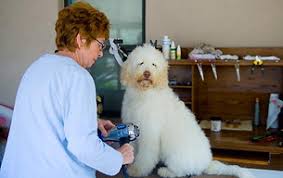In this article, we’ll be looking into what the Labradoodle dog breed is and also tips on how to groom one. The Labradoodle is a mixed-breed dog. The Labrador Retriever and the Poodle were crossed to create it.
The easiest method to predict a mixed breed’s temperament is to research every breed involved and be aware that any two breeds can be crossed and produce a dog with any two breeds’ worth of traits.
Not every one of the designer hybrid canines being bred is 50% purebred and 50% purebred. Multigenerational crosses are frequently bred by breeders.
The Australian Labradoodle and the American Labradoodle are two entirely distinct breeds of Labradoodle. While the American Labradoodle is a hybrid dog, the Australian Labradoodle is a purebred canine.
Just like the Goldendoodle dog breed, the Labradoodle is very loving and caring towards its handlers. However, the behaviors and characteristics of a crossbreed cannot be static but dynamic as they are a blend of two distinct breeds.
Size and look can vary slightly between each Labradoodle. A midsize dog, for instance, can grow to be 50 cm tall and weigh up to 23 kg. A typical dog, however, can weigh up to 45 kg and measure up to 66 cm tall.
Labradoodles feature droopy ears, long legs, and a lean frame. They have a shaggy coat that has a variety of textures, from long and shaggy to woolly and curly. This breed has the advantage of not typically affecting allergy patients. They are frequently referred to as hypoallergenic breeds of dogs.
Labradoodles are sociable, self-assured canines that are excellent with both people and other animals. However, when they become enthusiastic, they may be raucous and may trip up young children. As a result, make sure you enroll your dog in puppy preschool as soon as possible.
The Labradoodle is a smart dog with a pleasing disposition. As a result, they frequently end up as service and therapy dogs. The breed is peaceful and amiable with most people, but it doesn’t make a good watchdog.
Read Also: Great Pyrenees Dogs: Description and Complete Grooming Care Guide
To keep your energetic Labradoodle happy, go to the dog park or take a long daily walk. Although versatile, this dog prefers a home with a sizable backyard where it can run around and explore.
Give your Labradoodle plenty of opportunities to engage their intellect through training and games like fetch, scent, and agility. Your Labradoodle might enjoy playing in puddles or perhaps going for a swim because of the Labrador streak in the breed!
The coat of a Labradoodle typically doesn’t shed much or trigger allergies, making it a breed that many people enjoy. However, to maintain their thick coat, Labradoodles with woolly coats must go to the dog groomer every six weeks.
These sharp canines adore playing, running, and meeting new furry companions. Therefore, having another dog around during the day is excellent for your Labradoodle. Additionally, hours of alone time for your dog might lead to undesirable behaviors like chewing and digging.
Not always does his affection for his family extend to others. His Poodle parent is reputed to be a little reserved among strangers, which is seen in certain Labradoodles. They make excellent watchdogs since they will bark at approaching strangers. However, he isn’t the best guard dog because of his adorable, cuddly appearance.
Labradoodle Grooming Care Guide

1. Ear Care
Labradoodle should always have a clear vision and shouldn’t have nose-bridge hair growing up into its eyes or dangling and obstructing them. Trim the hair around the eyes and over the nose bridge with blunt-tipped scissors to prevent eyesight obstruction.
Hair that drapes over the eyes should be properly cropped so that it blends into the sides of the face and across the brow. Use eye wipes every few days to keep your dog’s eyes clean if they develop eye gunk.
2. Nail Clipping
Like humans, dogs have growing nails, therefore they will need to be trimmed, especially if they don’t frequently walk on uneven surfaces like concrete walks. Every time their coat is trimmed, your dog’s nails should be done as well, and most dog groomers typically include this service in their cut.
Of course, you have the option of doing your dog’s nail trimming at home. If you decide to do this, make sure to ask your veterinarian or pet groomer to demonstrate how to properly clip the nails.
Read Also: Tibetan Mastiff Dogs: Description and Complete Grooming Care Guide
3. Bathing
The lifestyle of your dog will determine how frequently you should bathe him. Bathing will happen more frequently if the dog spends most of its time outside, exercises frequently, and/or swims frequently.
Labradoodles typically don’t have an odor, and the oils in their coats help to keep them somewhat dirt-resistant. Over-showering might dry out the coat’s oils and harm it. Every three to four weeks, I bathe my dogs.
4. Body Care
The body can be cut to the length that best fits the lifestyle. The tail needs to be straightened. The tummy can be cut shorter or even shaved in the summer to keep the dog cool if the body is left long.
5. Brushing
It’s crucial to begin brushing your dog as soon as he or she joins your home. At least four times each week, until the adult coat is completely developed, give your dog a full body brushing.
The mature coat will likely develop when your dog is roughly 18 months old. To begin, you will require a decent brush and a de-matting comb. To make little adjustments around the eyes, you should definitely get some scissors with rounded points.

